Not quite VPEC-T
Last night, I am very pleased to say, I completed my new book Mapping the Enterprise: modelling the enterprise as services with the Enterprise Canvas – just in time, I hope, to have printed copies available in hand at the Open Group/Biner enterprise-architecture conference in Stockholm in less than two weeks’ time.
As part of the development work for the book, I needed a model or frame that helps us to assess the content of flows between service and other services or stakeholders, as shown by the coloured arrows in this diagram of the core Enterprise Canvas. (One important point is that the bidirectional flows represented by the upper pair of arrows occur before a transaction on the main-channel; the left-to-right supply-chain flows occur during a transaction; and the right-to-left flows occur after a transaction, as the ‘return-channel’ – payment and the like.)
I wanted to use Nigel Green’s VPEC-T for this, but quickly found that its standard structure works best with information-only flows (which is hardly surprising, since the book is billed as “A handbook for information-systems for the 21st century”). I ended up doing a kind of rethink/rework of some of the core ideas to fit better with the ‘before/during/after’ flow of the Canvas, as can be seen in the following extracts from the book. It includes one definitely-significant change from the original – changing the role of VPEC-T’s ‘Content’ to ‘Completions’. Since I really value my conversations with Nigel, and I really really want to avoid another Cynefin, I ought to emphasise very strongly that this is not VPEC-T, and hence it has a different name to emphasise this (‘service-flow content’). It’s inspired by VPEC-T, certainly, but in no way does it claim to ‘replace’ it or anything like that. I do hope that it’s a useful counterpoint and alternate-perspective for the VPEC-T crew, though – and comments welcome, of course.
Service-flow content
The main content of a service-flow – its payload – will consist of a context-specific mix of asset-types, which should be assessed [as described earlier in the book: assets may be physical, virtual (data etc), relational (links between real-people) and/or aspirational (brands etc)]. In addition, there will also be various ‘wrappers’ which are not necessarily the payload itself, but are essential in maintaining the integrity of the overall service.
Service-flow content ‘wrappers’
This section of the content-assessment is based on the VPEC-T framework developed by Nigel Green and Carl Bate. Note, though, that this is an adaptation for use with the Enterprise Canvas, and differs significantly from the original in some places – in particular, the ‘Content’ dimension from VPEC-T has been replaced here with a ‘Completions’ dimension that has a somewhat different role.
We can categorise these according to the part that they play in the overall flow, and also in the market-cycle: Values, Policies, Events, Completions, Trust.
Note that in many cases these ‘wrapper’ flows will take the form not just of a single ‘package’, but a back-and-forth interaction that may comprise many messages and asset-exchanges between any two or more distinct parties. There may also be service-critical stages within the overall interactions of each of these ‘wrappers’ – for example, see the distinct ‘Completions’ stages [in relation to strategy etc, which we’ll see later].
Service flow content and the market-cycle
Values represent “that which defines the flow” – the overall values that frame the context of the flow, and in which the quality of the results will be assessed. This type of content is often a precursor to any interaction via either the Supplier-Relations [RS] or Customer-Relations [RC] cell, or direct with the Value-Proposition [VP] cell.
Policies represent “that which directs the flow” – the decisions, rules and reasonings to guide subsequent activities that would (in principle) add value to the content of the flow. This type of content is often an outcome of any interaction via either RS or RC, or direct with VP, but also may be a prerequisite to an Event flow on a main-channel (Supplier-Channel [CS] or Customer-Channel [CC]).
Events represent “that which triggers the flow” – the triggers that mark the initiation of action on the content of the flow. This type of content is a precursor to a transaction on the main-channel (CS or CC), and will often contain information and other content as part of the event-trigger. In conventional process-models, this would also represent the ‘start-event’ marker for the process.
Completions represent “that which validates the flow” – the flags that mark the end of the flow, and the metrics that are used to verify satisfactory completion for all parties to the flow. This type of content marks the end of a transaction on the main-channel (CS or CC) – in conventional process-models this would represent the ‘end-event’ marker for the process – but also marks the start of the matching interactions on the return-channel (Value-Outlay [VO] or Value-Return [VR]).
Trust represents “that which dominates the flow” – the feedback on the perceived value of the flow, and belief in future efficacy (effectiveness: efficient, reliable, elegant, appropriate, integrated) of equivalent future flows along this overall pathway. This type of content marks completion of a set of interactions or transactions on the return-channel (VO or VR). It would typically include metrics that verify customer-satisfaction and the like.
The core-content of a flow through a Relations channel (RS or RC) will typically be bounded by Values and Policies wrappers.
The core-content of a flow through a main-channel (SC or CC) will typically be bounded by Events and Completions wrappers.
The core-content of a flow through a return-channel (VO or VR) will typically be bounded by Completions and Trust wrappers.
Five Elements
Another useful frame here – Five Elements – is a counterpart to the Effectiveness frame [described in the previous chapter in the book], that describes services in terms of continuous lifecycles.
Five Elements: five phases in the continuing lifecycle
This is derived in part from Bruce Tuckman’s well-known Group Dynamics model of the project life-sequence: forming, storming, norming, performing, adjourning. In Five Elements, these align to Purpose, People, Preparation, Process and Performance. Here, though, the stages form a continuous cycle, conventionally starting at Purpose.
The same pattern will also repeat across an organisation, with different business-units enacting different parts of the cycle:
- Purpose: strategy, futures, business-intelligence, corporate identity, brand
- People: HR, training, organisational development, narrative-knowledge, health and safety, security
- Preparation: planning, scheduling, project-management, procurement, infrastructure, logistics
- Process: production, manufacturing, sales [in a sales-context], any ‘service-delivery’ function
- Performance: book-keeping, performance-records, accounting, audit, archive; also ‘lessons-learned’ review
Each grouping also has its own specific perspective on time: far-future, ‘people-time’, near-future, ‘now!’ and past respectively. It’s important to note these differences in time-perspectives, because they can often lead otherwise ‘inexplicable’ clashes between the groups.
Five Elements and service-flow content
The service-flow content-dimensions – Values, Policies, Events, Completions, Trust – in effect form the boundaries between the phases in this overall cycle. Or, to put it the other way round, the Five Elements groupings identify the sets of activities that need to occur in order to deliver the respective node or dimension in the service-flow content.
Enterprise Canvas and continuous lifecycle
Linking together both the Five Elements set and the service-flow content-dimensions into a single sequence, we can also see how they link together moving ‘downward’ on the Enterprise Canvas, with Five Elements as the backplane and the service-flow content set as their expression to the service’s ‘outside world’.
So for the service overall, for each of its cells, and for each of its flows, we need to ask:
- Who or what is responsible for the Purpose of this item? (This should link strongly with the Value-Proposition cell, for example, and also the ‘direction’ guidance-services.)
- Who or what is responsible for the People-issues for this item? (This is where the ‘validation’ guidance-services are likely to play a key part in the service and, for external links, the Supplier/Customer-Relations cells.)
- Who or what is responsible for the Preparation and scheduling for this item? (This should link strongly with the Value-Governance cell, and also the ‘coordination’ guidance-services.)
- Who or what is responsible for the Process and action of this item? (This should link strongly with the Value-Creation cell, probably the Supplier/Customer-Channel cells, and probably also the ‘coordination’ guidance-services.)
- Who or what is responsible for the overall Performance of this item, including completions and lessons-learned? (This should again link strongly with the Value-Governance cell, the Value-Outlay/Return cells, and also the ‘validation’ guidance-services.)
- Who or what is responsible for integration between all of these domains – such as in resolving clashes in time-perspective between the groups?
Strategy and lifecycle completion
The Five Element model also provides an important view into the relationships between strategy, tactics and operations:
- strategy is about the relationships between the organisation and the enterprise, between the organisation and the people who work within it, and between the organisation and its various ‘external’ stakeholders – relationships which mostly centre around identity, belonging and feeling
- tactics is about translating those relationships into explicit plans for action in the near-future – activities which mostly centre around analysis and thinking
- operations or ‘execution’ is focussed on action in the immediate present – everything here will centre around doing
The overall flow of the activities-lifecycle passes through each of these modes in turn – which in practice means that an explicit balance needs to be maintained between them.
Strategy, tactics, operations: links to Five Elements
However, the modes also often represent fundamental differences in mindset and worldview – which can lead to serious problems if any one of the modes comes to dominate over the others.
Short-term, medium-term, long-term
We can perhaps see this most easily via a cross-map to the market-cycle. The Completions section of the cycle actually consists of three distinct stages – each of which offers a choice as to whether to continue in the cycle, or loop back to an earlier stage.
Short-term failure: operations mistaken for strategy
The ‘short-term’ version loops back to the next task as soon as the current main-channel task is complete, without checking for completion of anything coming back along the return-channel. This is typical for any production-oriented service, though can often work quite well if there is linkage to another service that can take over the main cycle at that point. The catch is that it must assume that there are no changes at all in the context, because it has no means within itself to adapt to change: if there is any change in the context, the service will usually fail. If an obsessive focus on ‘doing’ comes to dominate so much that operations itself is taken as ‘strategy’ – as in the fixed Five Year Plans of the old communist era, for example – then system-failure is guaranteed in the relatively short-term.
Medium-term failure: tactics mistaken for strategy
A more common source of failure-risk occurs at the second Completions-choice, which occurs early in the Performance phase. In a commercial context, this is the ‘monetisation point’, the point at which payment has been received, and in which the financial part of the transaction is complete: from the service’s perspective, a basic ‘satisfaction for self’ has been achieved. In services that are dominated by notions of ‘results’ – as is all too common in business – there is then a tendency to want to loop back straight away to a point somewhere within the Preparation phase, to set up the next transaction and get back to ‘monetisation’ as quickly as possible. This leads to a situation where relatively short-term tactics are mistaken for strategy – as in the classic pseudo-strategy of “our strategy is last year’s target plus 10%”.
The problem is that the overall transaction – ‘satisfaction for all’ rather than solely ‘satisfaction for self’ – was never completed, there is no reaffirmation of mutual Trust, and the all-important reconnections with Purpose and People were never made – often dismissed as ‘unnecessary overhead’. The result is an initially slow yet accelerating deterioration of trust within the market, and a widening disconnect from the enterprise and the people within and beyond the organisation – setting the stage for an increasingly desperate yet apparently ‘inexplicable’ slide into irrelevance. So this too can be an all-but-guaranteed recipe for service-failure over the longer term.
The reality, though, is that the full Five Elements cycle can be very time-consuming, and a too-frequent review of Purpose and even of People will not only be an excessive overhead in most contexts, but will soon become an extreme annoyance as well. In practice, especially in most production-oriented environments, it usually is safe to take those two ‘short-cuts’, to keep the overall flow moving as quickly as possible, for everyone’s satisfaction. The keyword, though, is “usually”: the trick is to know when it’s safe to do so, or when we do need to work our way through all of the Completions, carefully, and in sequence. There are key questions there that need to be asked in any service-design with the Enterprise Canvas.
- Is there a choice in the service’s handling of Completions where it can short-cut back to start straight away on the next task? If so, to what other service is the responsibility passed to handle the remainder of the service’s Completions? What processes and decisions ensure that the service does continue on through the whole of the Five Elements cycle at appropriate intervals?
- Is there a choice in the service’s handling of Completions and Performance where it can short-cut back to set up the next transaction? If so, to what other service is the responsibility passed to handle the remainder of the service’s Performance activities? What processes and decisions ensure that the service does continue on through the whole of the Five Elements cycle at appropriate intervals?
- What decisions and processes are needed to ensure an appropriate balance at all times between strategy, tactics and operations – between feel, think and do?
[end of extracts]
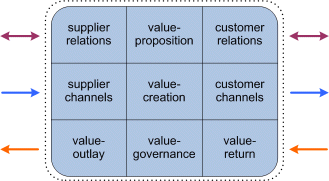
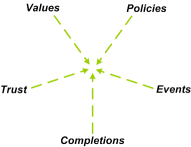
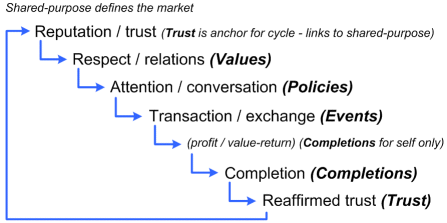
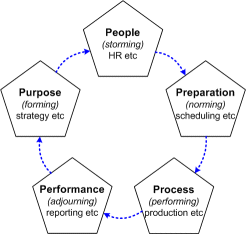
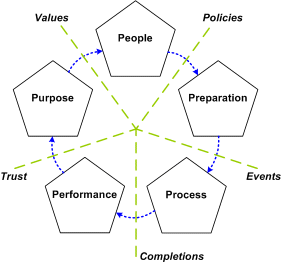
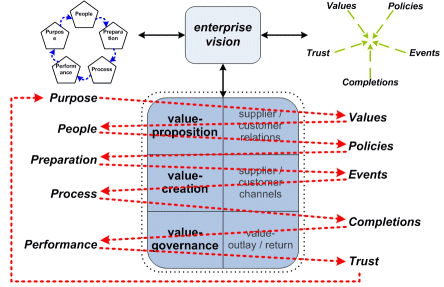
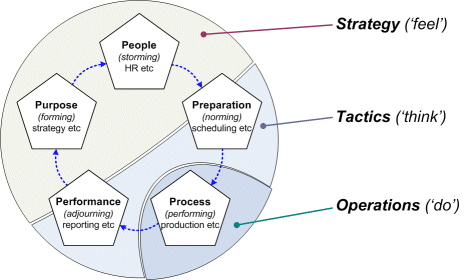
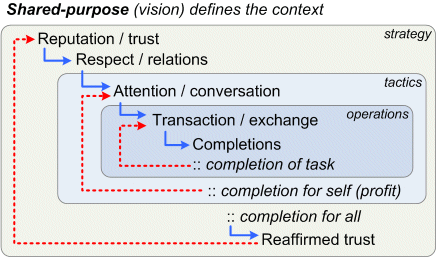
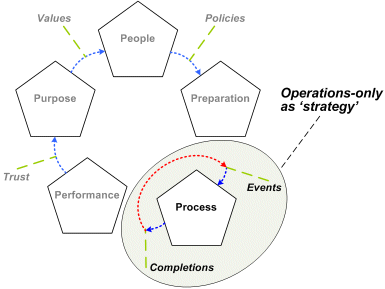

Very exciting.
This is a brief overview and am looking forward to reading the entire book.
The examples you picked are within a corporate wall (people=HR etc). Will you add more comments and examples that illustrate beyond the corporate wall?
Will social media impact be considered an event?
Thanks Pat!
The whole book will be available shortly (my notes to do the e-book conversion are back in England, which I won’t be able to get to until later this week).
Other parts of the book do definitely extend beyond the corporate wall, to the market and the broader shared-enterprise. The example I used in much of the book was a fictitious shoe-manufacturer and retailer, and how it connects with its market and beyond.
Social-media impact is very important and would indeed be an event, though it isn’t discussed in detail – there’s too much scope to cover already! The two concerns about social-media that are explicitly mentioned are the way that it leverages the impact of anti-clients, and a happier example of a customer who makes a YouTube video about unboxing her new shoes and how much she’s enjoying them.
More later: will keep in touch, anyway – and thanks again.
Congrats Mr. Graves.
Looks like you’ve really pulled it all together – ‘one map to rule them all’ as you promised. It has a ‘whole is greater than the sum of its parts’ quality, where the referenced frameworks gain clarity by inclusion on the Enterprise Canvas. I look forward to reading the book.